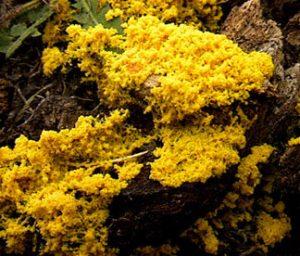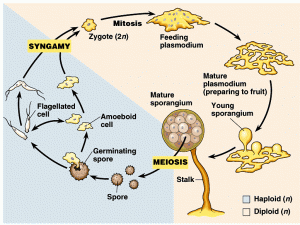- The slime molds are mostly eukaryotic microorganisms which are mostly unicellular but can aggregate to form a multicellular organism. These have their own classification within Protista because of their uncommon morphology.
- They show clearly protozoan characteristics at some stages in their life cycle, however at alternative stages, they become almost fungus-like.
- Slime molds comprise two distinct teams that aren’t closely related: the cellular slime molds and also the true, or one-celled, slime molds.

- A distinguishing morphological difference between the two teams that are the vegetative state of cellular slime molds in an exceedingly haploid ameboid cell.
- The vegetative state of one-celled slime molds could be a cell organ diploid ameboid mass known as a plasmodium. each team grow in moist soil or decaying plant matter and are white, yellow, or red in color.
- Slime molds are mostly founnd in damp forest soils, tree bark, and dead or dying wood.
- A type of slime mold called Dog vomit fungus (Fuligo septica) which show up during warm, wet periods. These produce spores which are highly resistant.

LIFE CYCLE OF A SLIME MOULD
- Reproduction in slime molds involves the assembly of a structure known as a plant organ, that contains spores.
- Spores are special cells that are encased in an exceedingly powerful protecting coating.
- Every reproductive structure will turn out to be a replacement organism. Spores free by a slime mould turn out to be tiny amoeba-like cells.
- In one phylum of slime molds, every amoeba-like cell could develop into one cell that measures many centimetres in diameter.
- This massive cell contains several nuclei. Eventually, the massive cell settles in one place and produces mature bodies.
- The vegetative part of the cellular slime molds is an ameboid cell. looking on environmental conditions, these cells can enter either the sexual or the asexual reproductive part.
- For reproduction, two cells of opposite sex types fuse to make a diploid cell. As alternative ameboid cells reach this cell, they’re phagocytized and large cell forms.
- This cell undergoes meiosis and becomes a macrocyst. reproductive structure formation takes place within the macrocyst, from wherever the ensuing haploid spores are going to be free.

ASEXUAL REPRODUCTION.
- The plasmodium part of the one-celled slime molds differs from the pseudoplasmodium of the cellular slime molds in that it is diploid.
- This mass offers rise to a plant organ during which meiosis happens and haploid spores are made. The spores germinate to provide flagellate gametes.
- These gametes fuse to make a diploid cell. The cell grows and its nucleus divides mitotically, however, the living substance doesn’t divide, leading to another plasmodium
SEXUAL REPRODUCTION.
- Sexual reproduction is most likely to require a place in terribly damp conditions. In drier conditions, cellular slime molds enter an asexual reproductive part.
- Haploid ameboid cells stop feeding and clump along to make a slug-like pseudoplasmodium. From this forms a stalked plant organ. during this plant organ spores will be produced and free.
References
- https://www.sciencedirect.com/topics/earth-and-planetary-sciences/slime-mould
- https://www.thespruce.com/identifying-and-controlling-dog-vomit-fungus-2539510
- https://sarahlloydmyxos.wordpress.com/welcome/child-page/